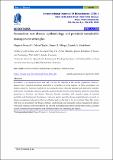| dc.description.abstract | Groundnut is an important food and cash crop for the majority of the world’s population. However,
diseases have impeded groundnut cultivation in groundnut-growing regions. Of them, groundnut rust
disease caused by Puccinia arachidis is one among the major diseases causing more than 50% economic
yield losses. For decades, chemical pesticide application has been the most effective option for controlling
groundnut in Tanzania rust disease. However, hazards associated with excessive usage of chemical
pesticides and development of pathogen- resistance against pesticides has prompted intensive research on
disease management alternatives that are effective and eco-friendly to the environment. Thus, this review
will focus on groundnut rust disease etiology, epidemiology and expounds various management options
with much emphasis on the potential of the selected pesticidal plant species (Azadirachta indica, Jatropha
curcas, Parthenium hysterophorus and Moringa oleifera) in combatting the disease. | en_US |

